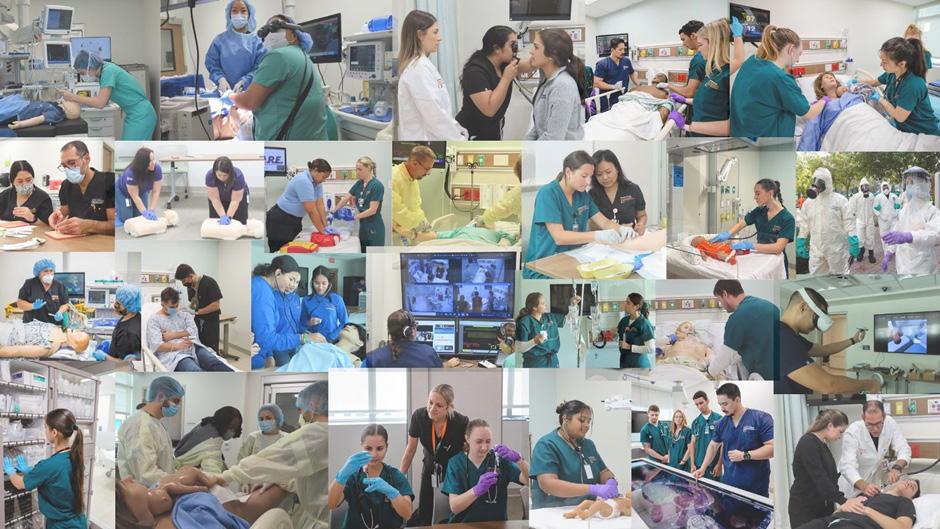Now in its sixth year of operation, S.H.A.R.E. continues to be a formidable vehicle for furthering the highest standards of nursing education at the School of Nursing and Health Studies (SONHS). Every day, dedicated faculty and staff employ the limitless capacity S.H.A.R.E. embodies to guide and inspire the future nursing workforce, as well as other learners and investigators seeking to improve patient safety outcomes.
Built to mimic a cutting-edge, fully functioning hospital, S.H.A.R.E. offers 41,000-square-feet of on-site, virtual, and extended-reality simulation opportunities for students to practice nursing in a variety of clinical, research, and educational settings. The quality of education taking place at S.H.A.R.E. is evidenced by its national accreditations. In 2020, the Society for Simulation in Healthcare granted SONHS and S.H.A.R.E. five-year accreditation status, with one of the noted strengths being the ability to deliver simulation education in the native language of visiting international students. Earlier this year, the International Nursing Association for Clinical and Simulation Learning awarded S.H.A.R.E. its three-year simulation standards endorsement. Both of these associations are dedicated to advancing simulation education. Their recognition, combined with accreditation from the American Nurses Credentialing Center’s Commission on Accreditation, is a testament to the S.H.A.R.E. educators and simulation specialists.
S.H.A.R.E. proved most useful almost three years after its opening, when students were unable to attend physical classes and clinicals due to the COVID-19 pandemic. Thanks to S.H.A.R.E.’s advanced technology, classes were easily transitioned to a virtual setting, wasting no time in keeping students prepared for re-entering their classroom and clinical sites. During this time, when hospitals were overwhelmed with COVID-19 patients, SONHS students were able to complete clinical hours in S.H.A.R.E.. Being able to complete these hours in a fast-paced, realistic, supportive environment well prepares students for clinical rotations at partnering hospitals.
In line with the School’s Education for Life strategic pillar, opportunities for simulation education at S.H.A.R.E. are not limited to SONHS students. In addition to hosting emergency medicine residents from UM/Jackson and nurse residents from area hospitals, the S.H.A.R.E. team is piloting basic first aid education courses and teaching SONHS staff how to perform adult, adolescent, and infant CPR—relatively simple procedures that those without medical training can perform while waiting for first responders. Once pilot phases are complete, these and other programs will be released for public use.
Furthering the team’s commitment to community engagement, in May of this year, middle and high school students took part in “A Day in the Life of a Nursing Student” at S.H.A.R.E., where educators taught them basic nursing procedures in an immersive simulation-based environment. This is just one of the many ways S.H.A.R.E. staff members are working to better their local, hemispheric, and global communities.
At the heart of this work is a desire to improve the quality of human life. This desire is fulfilled through research conducted in the realms of patient safety, disaster preparedness, health disparities, and more. Special patient safety sessions run during Patient Safety Awareness Week every March, raising awareness of unsafe practices and errors that can lead to death, helping prepare students to prevent such outcomes at all costs. This September, for Simulation Healthcare Week this September, the annual S.H.A.R.E. simulation team appreciation luncheon was hosted. In addition, SONHS students and faculty had the chance to try out virtual headsets with pre-programmed scenarios that enabled them to “enter” a virtual dimension in order to provide care for a simulated pregnant patient, from taking vitals and listening for a fetal heartbeat, to checking the chart and administering meds. For many participants, this was their first time experiencing the virtual world.
Large-scale simulations have been run to develop and standardize protocols responding to serious disaster scenarios: hurricanes, active shooters, disease outbreaks, to name a few. Faculty have developed courses to train nursing students to identify and assist human trafficking victims in safe, proactive ways.
Forward-looking XR (augmented, virtual, and mixed reality) technologies have been developed by the University in collaboration with nursing faculty, including technology that is now being used to help nurse anesthesia students familiarize themselves with the operating room in advance of clinical placement.
Research opportunities like these aren’t limited to S.H.A.R.E. faculty and students. In alignment with SONHS’s Hemispheric Leadership and Mission Driven Research pillars, ongoing collaborations with local, national, and global institutions strengthen the School’s position as a leader in simulation health care. These collaborations exhibit the desire to keep sharing, keep learning, and keep growing.
This dedication to growth is at the heart of innovation, which was demonstrated at the International Meeting on Simulation in Healthcare (IMSH), which S.H.A.R.E. educators attended in January 2023. As evolved a facility as S.H.A.R.E. is, those who work here know they must keep up with new technology and advances. Members of the S.H.A.R.E. team attended IMSH with the goal of gaining more insight into the evolving world of health care simulation, eager to take this knowledge back to colleagues and students.
Even with all this new technology bringing students the best technical skills possible, educators at SONHS are still committed to teaching their students the importance of human touch, kindness, and care. This lesson is important for them to learn as simulation cannot provide those things for patients. This potent combination of best practices in clinical nursing education and rigorous, cutting-edge simulation education has brought SONHS global recognition for graduating qualified, compassionate, innovative RNs, nurse practitioners, and nurse anesthetists. As technology continues to advance, S.H.A.R.E. and SONHS will aid in its progress, leading the world of health care into a better future.

